Tuesday, January 31, 2012
You know something's not right when...
...you find out that you have different editions of the same novel.
 What can I say? I'm a big Edith Wharton fan.
What can I say? I'm a big Edith Wharton fan.
Labels:
reading
Sunday, January 29, 2012
This sequel lacks the oomph of the first
Fans of Carlo Vergara's graphic novel, Ang Kagila-gilalas na Pakikipagsapalaran ni Zsazsa Zaturnnah, must be eagerly anticipating the sequel, the first part of which has just been released in the metro last week. Everyone loved Vergara's protagonist -- a nelly-ish gay guy who transforms into a Wonder Woman type of superhero named Zsazsa Zaturnnah. The first compilation was très enjoyable to say the least.
The sequel though, specifically the first of a planned three volumes, seems like an afterthought. Reading Zsazsa Zaturnnah sa Kalakhang Maynila feels like eating tofu after fasting for a long time -- it just doesn't satisfy you. For one, it's not as campy as the first. Yes, there are loads of gay lingo scattered throughout the dialogue, but these lines feel a bit contrived. They don't add to the humor at all; there are no LOL moments, just sniggers here and there if you do get the pop culture references.
Also, as a graphic novel, the sequel can get too talky in my opinion. I expect graphic novels to use the illustrations to tell the story. The long lines of text just draw the reader's eyes away from the drawings. Just look at the spread below to see what I mean.
Vergara has also introduced characters into the now diluted and uninteresting narrative. We're now acquainted with a superhero with bulging body parts here and there. Vergara is teasing us with this character. How could this mass of testosterone figure in the next 2 installments? What could possibly be the outcome of a partnership between him and Zaturnnah? Of course, the reader is made to wonder as to his alter ego.
Vergara's illustrations are still beautiful though. They're just as detailed and clean as the original. It's worth shelling out a few bucks just for the illustrations, which I think unfortunately is one of the very, very few reasons to get this graphic novel.
Oh well, here's hoping that the 2nd and 3rd installments improve on this volume. Bring back the fun, camp, and one liners please!
Read this book if:

- You love graphic novels with a bit of camp.
- You're comfortable with gay lingo.
- You love graphic novels in series.
Thursday, January 26, 2012
Still 20/20 after all the reading
Photo courtesy of Rhett
One day, I will wake up with a need for reading glasses. But for now, I'm still enjoying the fact that my vision is still perfectly clear. Hey, I need good vision for my job, as I'm a book editor. And I still have a mountain of a TBR pile to go through. So, 20/20 vision, please stay with me for a few more years.Nevertheless, I doubt if a pair of uncool-looking reading glasses would stop me from reading. Perhaps in a few years, they'd make a scientific breakthrough -- making people's vision as accurate as those of the owl on my shoulder.
Happy reading, everyone! And please take care of your precious eyes!
Labels:
reading
Tuesday, January 24, 2012
Read this book aloud
If you're a big fan of the works of Dr. Seuss, then you'll surely appreciate Robert Paul Weston's wonderful children's book, Zorgamazoo. It's a fictional work that is entirely written in verse, which I think is a feat in itself.
Here is a storyZorgamazoo is about two characters, a human named Katrina and a zorgle named Morty, and how they embark on an adventure that's truly out of this world.
that's stanger than strange.
Before we begin you may want to arrange:
a blanket,
a cushion,
a comfortable seat,
and maybe some cocoa and something to eat. [page 3]
Weston writes about a world underneath our normal one, where strange-looking creatures live. It's a place called Zorgamazoo populated by ogres, mermaids, fairies, and other fantastical creatures. And one day, all these creatures mysteriously disappear. Morty unwillingly embarks on the quest after having his name drawn in a lottery. Katrina, on the other hand, is a girl always on the lookout for adventure. It's a mismatch ripe for many possibilities.
It becomes impossible for the reader to not go through this book in one sitting. For one, the illustrations of Victor Rivas Villa, which appear at the start of every chapter and intermittently in the inside pages, are delightful. His style is very distinct and quite appropriate for children.
I also think that the publisher made it a point to vary the typefaces used for some words, probably to avoid the monotony of having chunks of stanzas on every page. It's a very good technique, if I may say so, for it highlights some of the key words in the story. Katrina's name for example, when it appears in full in the text, is written in large classic serif type.
Of course, the main reason a lot of people would love this book is Weston's witty verse. There's a pleasant rhythm when you read the stanzas aloud. There's never an awkward nor a contrived line. Everything works perfectly. This is a book that you read to your children as you tuck them in bed.
And you better be careful when you take this book somewhere public like in a bus or the library. You won't be able to stop yourself from reading Weston's fabulous verse out loud.
Read this book if:
Labels:
children's books,
contemporary fiction,
debut fiction,
illustrated,
reviews,
verse
Sunday, January 22, 2012
The bookshelf project #29
This week's pictures of bookshelves are from Tina, a fellow Filipino book blogger. Tina usually writes about young adult books. Check out her awesome blog entries here.
I always make it a point to visit Tina's blog when I'm craving for YA fiction. Her reviews are really helpful and quite insightful. Let's check out Tina's shelves, shall we?
To enlarge the pictures, press the Ctrl key and then click on the pictures. The enlarged versions will open in a new window.
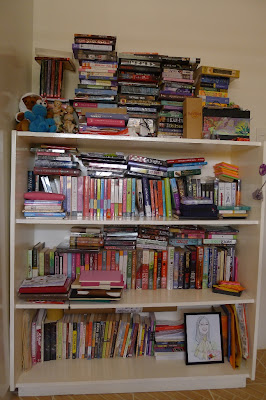 Wow! I definitely need a ladder to reach the topmost books. Let's see the shelves in closeup.
Wow! I definitely need a ladder to reach the topmost books. Let's see the shelves in closeup.
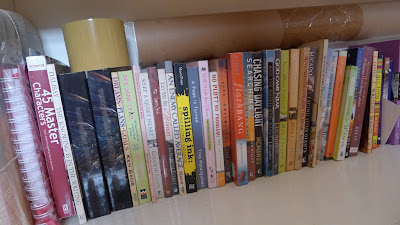 Here are Tina's nonfiction books. Tina is deeply spiritual and she went to Spain last year for World Youth Day. See the loads of books with religious themes. Tina's also a writer, by the way.
Here are Tina's nonfiction books. Tina is deeply spiritual and she went to Spain last year for World Youth Day. See the loads of books with religious themes. Tina's also a writer, by the way.
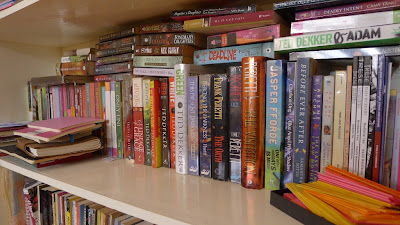 The non-YA shelf. Lots of Peretti and Dekker. And those gritty Trese graphic novels are such a joy to get lost into.
The non-YA shelf. Lots of Peretti and Dekker. And those gritty Trese graphic novels are such a joy to get lost into.
 The YA shelf. I notice a lot of romantic YA fiction by Dessen, as well as fantasy titles by Yancey, Cashore, and Turner. And, woot woot, Ness's Chaos Walking books! I love those!
The YA shelf. I notice a lot of romantic YA fiction by Dessen, as well as fantasy titles by Yancey, Cashore, and Turner. And, woot woot, Ness's Chaos Walking books! I love those!
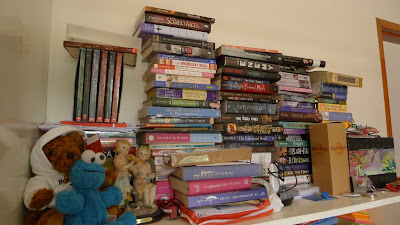 And of course, the sacred TBR pile, which every true blue bibliophile learns to live with. So Tina still has to sink her teeth into The Girl with the Dragon Tattoo and A Game of Thrones. I'm sure she'll be a fan. Hey, I see The Wednesday Wars! It's my favorite book last year!
And of course, the sacred TBR pile, which every true blue bibliophile learns to live with. So Tina still has to sink her teeth into The Girl with the Dragon Tattoo and A Game of Thrones. I'm sure she'll be a fan. Hey, I see The Wednesday Wars! It's my favorite book last year!
I have shelf envy just looking at these pictures. How about you, dear reader? What do you think of Tina's shelves?
I always make it a point to visit Tina's blog when I'm craving for YA fiction. Her reviews are really helpful and quite insightful. Let's check out Tina's shelves, shall we?
To enlarge the pictures, press the Ctrl key and then click on the pictures. The enlarged versions will open in a new window.
I have shelf envy just looking at these pictures. How about you, dear reader? What do you think of Tina's shelves?
Labels:
The bookshelf project
Wednesday, January 18, 2012
Touching, heartfelt, and true
I am probably one of the few persons left on Earth who do not appreciate The Little Prince. I feel that its message is too zen, too cryptic at some points. Thankfully there's Craig Thompson's beautiful graphic novel, Good-bye, Chunky Rice, whose message is just as profound as Saint-Exupery's beloved work.
Good-bye, Chunky Rice is indeed a fable, a tale about the friendship between a turtle named Chunky Rice and a mouse deer named Dandel. Chunky Rice decides to leave Dandel behind to search for something missing in his life and to find the place where he truly belongs.
Chunky Rice then boards a ship in the company of several eccentric characters: the oily captain named Charles, an animal-loving man named Solomon, and Siamese twin sisters named Livonia and Ruth. Through these characters, Thompson seamlessly weaves subplots into Chunky Rice's adventure.
But Good-bye, Chunky Rice is still about, well, Chunky Rice. Maybe he was wrong to leave Dandel behind, for he was always happy in her company. Dandel constantly pines for her friend, always throwing at the sea bottles with messages intended for her lost friend.
Several readers would definitely glean different meanings in Thompson's exquisitely drawn graphic novel. For me, that message is one of friendship: how it is important to recognize the importance of people who are always with us, never taking their existence for granted. Chunky Rice and Dandel complete one another. When one left the other, there was a natural tendency to wish the other back.
I'm not sure Good-bye, Chunky Rice would be enjoyed by kids though. While the style of the illustrations do seem to be intended for young readers, some of the panels depict sensitive content.
Thompson is more famous for Blankets and, recently, for Habibi. Compared to these two, Good-bye, Chunky Rice is minute. (It runs for just over 100 pages, as compared with the more than 600 pages each comprising Blankets and Habibi.) However, its themes of friendship and loss are more than enough to give it weight.
Read this book if:

- You'll read anything by Craig Thompson.
- You love fables.
- You find turtles and deer mice cute.
Labels:
fable,
graphic novels,
reviews
Sunday, January 15, 2012
The bookshelf project #28
And then we're already in mid January! It seems as if we were just celebrating the New Year yesterday, no?
This year, I decided to revive KyusiReader's The Bookshelf Project. What better way to start off than a picture of a writer's bookshelf. Thank you, Kristine, for sending a photo!
Kristine's short story "Pet" has been included in this year Philippine Speculative Fiction 7. I can't wait to get my hands on this collection, as I thoroughly enjoyed PSF 6 when it was chosen as a book by the book club. (Note to self: must find a way to read Kristine's other published short stories and poetry.)
So, dear reader, what do you think of Kristine's shelves?
This year, I decided to revive KyusiReader's The Bookshelf Project. What better way to start off than a picture of a writer's bookshelf. Thank you, Kristine, for sending a photo!
Press the Ctrl key and then click the picture to enlarge.
Photo will appear in a new window.
We can see that Kristine is a big fan of Stephen King. Woot woot! And she has lots of fantasy, horror, and sci-fi books. I just love looking at well-thumbed paperbacks. They somehow show how much we've enjoyed reading them.Photo will appear in a new window.
Kristine's short story "Pet" has been included in this year Philippine Speculative Fiction 7. I can't wait to get my hands on this collection, as I thoroughly enjoyed PSF 6 when it was chosen as a book by the book club. (Note to self: must find a way to read Kristine's other published short stories and poetry.)
So, dear reader, what do you think of Kristine's shelves?

Labels:
The bookshelf project
Saturday, January 14, 2012
Give it up for Saba
 There's another dystopian novel that everyone's talking about -- Moira Young's debut novel Blood Red Road. It has recently won the Costa for Best Young Adult Novel, so I think that more and more people will be discovering this satisfying work of contemporary YA fiction.
There's another dystopian novel that everyone's talking about -- Moira Young's debut novel Blood Red Road. It has recently won the Costa for Best Young Adult Novel, so I think that more and more people will be discovering this satisfying work of contemporary YA fiction.Young's protagonist, Saba, is predictably strong willed. Saba lives in a dried-up area called Silverlake with her father, her twin brother Lugh, and her youngest sister Emmi. One day, a group of hooded riders abduct Lugh. Saba's father is also killed, and Saba promises to herself that she'll do whatever it takes to get Lugh back.
In the world of Blood Red Road, I kept asking myself where could Silverlake be? I keep thinking that it's somewhere in North America, where the weather has been so f****d up that it hardly rains anymore, resulting in the land's arid climate. Young never does disclose where Silverlake is, much less the reasons for Earth's condition in the novel. I guess it's a technique to compel readers to anticipate the rest of the books of the trilogy.
The language of the novel is something that takes getting used to. It's made up of broken English with hardly any regard for tenses, subject-verb agreements (gasp!), and punctuation marks to set off dialogue. Still, the rhythm of Young's dialogue is very engaging that I never did pay attention to these details while I was reading.
The day's hot. So hot an dry that all I can taste in my mouth is dust. The kinda white heat day when you can hear th'earth crack.Of course, there's so much more to this novel than just a story about one girl's quest. While the world building isn't as extensive as fantasy readers are used to, the circumstances in Blood Red Road did appeal to my love of the escapist and the speculative. It's a world where people have been addicted to a drug called chaal, which is controlled by a very powerful king called Pinch. And Saba's twin somehow plays a role in keeping the king in power for the next 6 years.
We ain't had a drop of rain fer near six months now. Even the spring that feeds the lake's startin to run dry. You gotta walk some ways out now to fill a bucket. Pretty soon, there won't be no point in callin it by its name. [page 7]
There's something derivative about Blood Red Road though. I couldn't quite put my finger on it. Maybe it's the story of the quest. Or perhaps Saba's nature which can get quite predictable in this genre. Nevertheless, Young's debut is outstanding. It is difficult to write another dystopian novel at a time when The Hunger Games is extremely popular. But Blood Red Road is more grounded in its themes, more plausible in its story. And for a first book of a trilogy, it has successfully done its purpose -- to make the reader hungry for the next book.
Read this book if:
- You love dystopian fiction.
- Broken English narrative doesn't bother you.
- You can be patient in waiting for the rest of the books of a trilogy or series.
Monday, January 9, 2012
Brotherly love
An enjoyable western novel is as common as frogs in a desert. That's why Patrick DeWitt's The Sisters Brothers is something that everybody should read. It's like western on crack.
So in DeWitt's Booker-shortlisted novel, we meet two brothers famous for being hired gunmen -- Eli and Charlie Sisters. Charlie is more brash than Eli, who seems to be falling in love with women who will simply give him the time of day. So when the Commodore decides to hire the brothers to murder someone named Herman Kermit Warm, it is Charlie who comes up with the plan and proposes to take a much bigger cut of the blood money from the Commodore.
Even though the novel's titled The Sisters Brothers, I think that Eli is the heart of the novel. It is through his character that DeWitt makes his narrative. And it is Eli who begins to question the way the two brothers lead their lives.
What's hilarious is how the two brothers find themselves in outrageous situations and yet Eli's voice is still deadpan. And the banter between the two brothers is priceless. One will always be surprised at the characters brothers meet along the way, from Oregen to San Francisco during the Gold Rush and finally to the Sierra foothills where Herman Kermit Warm is supposed to be.
Read this book if:
So in DeWitt's Booker-shortlisted novel, we meet two brothers famous for being hired gunmen -- Eli and Charlie Sisters. Charlie is more brash than Eli, who seems to be falling in love with women who will simply give him the time of day. So when the Commodore decides to hire the brothers to murder someone named Herman Kermit Warm, it is Charlie who comes up with the plan and proposes to take a much bigger cut of the blood money from the Commodore.
Even though the novel's titled The Sisters Brothers, I think that Eli is the heart of the novel. It is through his character that DeWitt makes his narrative. And it is Eli who begins to question the way the two brothers lead their lives.
What's hilarious is how the two brothers find themselves in outrageous situations and yet Eli's voice is still deadpan. And the banter between the two brothers is priceless. One will always be surprised at the characters brothers meet along the way, from Oregen to San Francisco during the Gold Rush and finally to the Sierra foothills where Herman Kermit Warm is supposed to be.
...'What about you, brother? Are you up for a fight?'So now I've read 4 out of the 6 Booker-shortlisted novels in 2011. I'm with the Booker jury on their shortlist, for they chose novels that are enjoyable and readable. And I have to say that The Brothers Sisters is my favorite so far.
'Hardly.'
Squinting, he asked, 'What's that under your coat?'
'A gift from the girl.'
'Is there to be a parade?'
'It's a simple bit of fabric to recall her by. A bonboniere, as Mother would say.'
He sucked his teeth. 'You should not wear it,' he said decisively.
'It's very expensive material, I think.'
'The girl has played a joke on you.'
'She is a serious person.'
'You look like the prize goose.' [page 147]
Read this book if:
- You have a soft spot for westerns.
- You love witty dialogues and outrageous situations.
- You'll read anything with the word "Booker Prize" on the cover.
Labels:
Booker,
Booker prize,
contemporary fiction,
favorite books,
fiction,
reviews,
western
Saturday, January 7, 2012
How to settle issues with your father
There's the science aspect of it, for one. Several pages in the book had my eyes glazing over. Now, I majored in science back in college and I consider myself pretty much knowledgeable on different concepts. But the book's treatment of quantum physics, the mechanics of time travel, the different dimensions in space-time gave me headaches.
Another thing would be my preconceived ideas. I was hoping for action. HTLSIASFU didn't have as much. In fact, I would consider the book as melodramatic overall, focusing instead on how the main character, Charles Yu, settles long unresolved issues with his father. His father has been missing, you see. And Charles, now a time travel technician, thinks that finding his father lies in a book entitled How to Live Safely in a Science Fictional Universe.
The writing is very beautiful though. Yu's prose is very vivid and fluid. He effectively captures the thinking of one person who seems to be living his life in limbo, trapped in different physical planes altogether. Yu's message becomes clear as the reader goes through the novel. You can't change your past, no matter how f****d up it turned out to be, so you might as well consider the present.
...Step out into the world of time and risk and loss again. Move forward, into the empty plane. Find the book you wrote, and read it until the end, but don't turn the last page yet, keep stalling, see how long you can keep expanding the infinitely expandable moment. Enjoy the elastic present, which can accommodate as little or as much as you want to put in there. Stretch it out, live inside of it. [page 233]Read this book if:
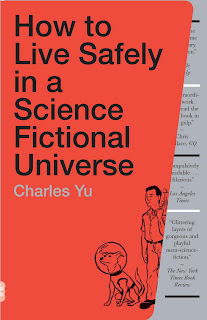
- You have unsettled issues with your father.
- You're comfortable with terms such as "chronodiegetic space" in a novel.
- You really think that living in a science fictional universe would be the best option for you, considering how messed up the real universe can sometimes be.
Monday, January 2, 2012
Smells like teen spirit
That's Andy's best friend above. Louie. That photo shows him shouting the P word to distract Andy from making the shot in a basketball game. Louie, however, isn't the main character in Daniel Clowes's Eisner- and Harvey-award winning graphic novel, The Death-Ray. Andy is.
The Death-Ray isn't about a superhero at all. It's a graphic novel about teen angst. Andy, the main character, somehow reminds me of Napoleon Dynamite. Almost every panel in this book depicts Andy as a loser. And it doesn't help that he's best friends with Louie, who is as much a loser as himself.
And so Andy and Louie go through their high school lives inconspicuously. Andy fancies himself to be the boyfriend of a blonde who he writes letters to frequently. The blonde lives next door. He also fantasizes about the African-American woman who takes care of his invalid grandfather. Things get a bit more exciting when Andy inherits the death-ray, a gun that zaps things to nothingness.
Of course, Louie tries to capitalize on Andy's weapon, urging Andy to zap the people that make their high school lives a living hell.
I was surprised to note that The Death-Ray is as much about a death ray than, say, The Da Vinci Code is about gay erotica. Andy is compared with Holden Caulfield in a lot of reviews. I haven't read Catcher in the Rye, but if HC is every bit as angstsy and introspective as Andy, then the comparison deserves merit.
Clowes's work is very episodic, with sections running at a page on the average. (The Death-Ray is a big book, so a page can have more than 20 panels.) There's plenty of space devoted to character development. By the novel's end, you see a part of yourself in Andy.
The drawings are very clean and a bit stiff IMHO. However, the stiffness works with Andy and Louie's apparent aloofness to the world around them. It's the kind of artwork style you'd expect to appear on a graphic novel that's more character centered than plot driven.
The Death-Ray has lots of panels showing faces and several lines of dialogue. The scenes involving the characters can be funny, though it isn't the usual in-your-face sort of humor. Again, it reminds me of the humor that's wonderfully employed in movies like "Napoleon Dynamite".
Daniel Clowes has earned a huge following, with his other works such as Wilson and Ghost World.
Read this book if:

- You like unconventional graphic novels.
- You identify with Holden Caulfield.
- You'll read anything that won the Eisner and the Harvey.
Sunday, January 1, 2012
Loving Lois Duncan
It's only recently that I've discovered how enjoyable Lois Duncan's books are. Despite the books being written in the 70s and early 80s, Duncan's thrillers and suspense novels are as enjoyable as ever.
Duncan has written more than 50 novels in her career, but she's famous for a handful of books that have provided chilling entertainment to young adults. I believe these novels number about 8, with I Know What You Did Last Summer and Killing Mr Griffin as the most famous ones.
I've read four of these novels. And let me tell you, dear reader, that these are one of the most creepy books you'll ever read, young adult novels or otherwise.
I read all four novels, one after the other, all in 2 days. Yes, they're that readable and entertaining. And yes, I'm going to read more.
Subscribe to:
Posts (Atom)





